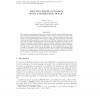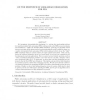107
Voted
SPIN
2010
Springer
14 years 11 months ago
2010
Springer
This paper addresses the problem of verifying programs for the relaxed memory models implemented in modern processors. Specifically, it considers the TSO (Total Store Order) relax...
113
click to vote
RAID
2010
Springer
14 years 11 months ago
2010
Springer
Network intrusion detection systems (NIDS) make extensive use of regular expressions as attack signatures. Internally, NIDS represent and operate these signatures using finite au...
JUCS
2010
14 years 11 months ago
2010
: Generalized finite automata with weights for states and transitions have been successfully applied to image generation for more than a decade now. Bilevel images (black and whit...
102
click to vote
JALC
2007
15 years 20 days ago
2007
Merging states in finite automata is a main method of reducing the size of the representation of regular languages. The process has been extensively studied for deterministic fi...
116
click to vote
JALC
2007
15 years 20 days ago
2007
The basic finite automata model has been extended over the years with different acceptance modes (nondeterminism, alternation), new or improved devices (two-way heads, pebbles, ...
93
Voted
IPL
2007
15 years 20 days ago
2007
We present a new proof of PSPACE-hardness of the emptiness problem for alternating finite automata with a singleton alphabet. This result was shown by Holzer (1995) who used a pr...
87
Voted
IJFCS
2007
15 years 21 days ago
2007
We investigate deterministically simulating (i.e., solving the membership problem for) nondeterministic finite automata (NFA), relying solely on the NFA’s resources (states and...
90
Voted
FSTTCS
2008
Springer
15 years 1 months ago
2008
Springer
We consider the construction of finite automata from their corresponding regular expressions by a series of digraph-transformations along the expression’s structure. Each interm...
80
Voted
DLT
2007
15 years 2 months ago
2007
Abstract. Inapproximability results concerning minimization of nondeterministic finite automata relative to given deterministic finite automata were obtained only recently, modul...
93
Voted
HYBRID
1995
Springer
15 years 4 months ago
1995
Springer
This paper summarizes the definitions and several of the main results of an approach to hybrid systems, which combines finite automata and linear systems, developed by the author...


